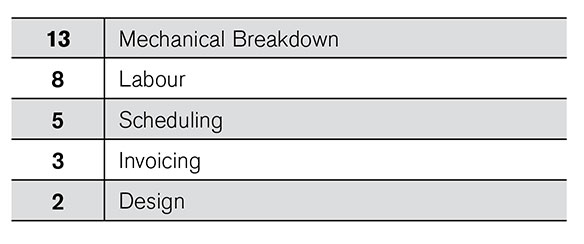
Features
Business
Guest Column
Know the problem
Calculate which problems deserve your attention and have the most impact on your business.
December 14, 2020 By Jacqui Empson Laporte
 Every workplace has fires to put out, including drainage and agriculture. There are methods to problem solve and patch up areas of concern in your business.
Every workplace has fires to put out, including drainage and agriculture. There are methods to problem solve and patch up areas of concern in your business. The cancellation of events due to COVID-19 opened up more space for reading. Recommended by a coworker, I read a book called Upstream: The Quest to Solve Problems Before They Happen by Dan Heath.
The book’s premise is that we tend to react to problems and put out fires, rather than preventing them from occurring in the first place.
Every workplace has fires to put out, including drainage and agriculture. I’d like to share what I learned and tie these takeaways to drainage.
The author suggests that there are three barriers to overcome in preventing problems.
The first barrier is problem blindness. Some problems are small and incremental, but they have a significant impact on your operation because they happen all the time. Other problems are deemed “inevitable” and therefore our motivation to fix them is limited.
The second barrier is a lack of ownership. The issue might impact us, but it is perceived as someone’s else problem to solve. This type of thinking can easily fall into a blame game. For example, you have a scheduling problem for a job site, but it’s the other contractors who are holding you up.
The final barrier is tunnel vision. We are so busy with day-to-day work that we can’t focus on the bigger picture, even though the looming challenges are likely to become our priority at some point.
Identify your problems
My manager uses the phrase “wash it with data” all the time, and I’d like to show you a couple of ways you can use data to overcome your three barriers.
The first is called a Pareto chart, where you track the frequency of problems that occur.
To begin creating a Pareto chart, you can create the categories you need. Problems can fit into weather event, scheduling conflict, equipment breakdown, paperwork error (in permits, invoicing, etc.) or other categories. You can track them however works best for you: a whiteboard, an Excel doc in the office or a notepad in the truck. It’s also important to get feedback from your employees as well – they may see problems that you don’t.
Rather than responding to the “fires” such as the immediate mechanical breakdown, the Pareto chart might point you towards a bigger problem. For example, a piece of equipment that is costing you in downtime or a need to revise a preventative maintenance plan. The data gathered provides valuable insight into cost of production.
While the Pareto chart will help identify the problems occurring most frequently, it doesn’t give you the potential impact on the sustainability of your business. A problem event happening even once might be catastrophic to your business. Another interesting tool is one that combines frequency x impact x predictability.
For example, you make a list of the challenges in your business. Next you can assign a range for each factor – for example 1 (less serious) to 5 (more serious). To calculate the total score, you multiply frequency by impact, then predictability.

For this method, you make a list of the challenges in your business. Next you can assign a range for each factor – for example 1 (less serious) to 5 (more serious). To calculate the total score, you multiply frequency by impact, then predictability.
In this example, running out of tile or a machine breakdown will interrupt the plans for your day, but the total scores would indicate that addressing accurate invoicing would be the best for the business. If the predictability of invoicing problems is high, and the impact is high, then perhaps you need to look at your processes in managing estimates, quotes, in field material use, time tracking, and invoicing. The end result might seem like an inaccurate invoice, but the problem actually stems from somewhere along the process from estimate to construction.
If a good employee starts calling in sick more often (frequency), which is abnormal for them (predictability or how well you can foresee the issue happening), then perhaps it’s time to find out what is going on and whether that person needs assistance. That might turn out to be less about the job and more about issues outside of work. If the frequency is high and predictability is also high, then perhaps it’s time to address attendance in other ways.
Your chart might look completely different, and that’s okay. The important part is the method of trying to focus your effort on the things that will make the most impact on your business. Again, it’s important to involve other employees in your business because they may view the frequency or impact differently than you.
As we head into the quieter months, take time to reflect on your business and which reoccurring problem areas could use an upgrade before next season.
Print this page